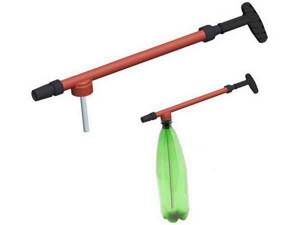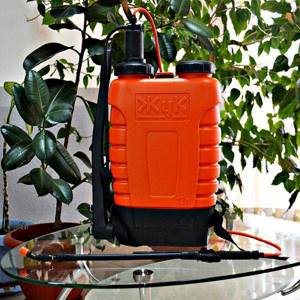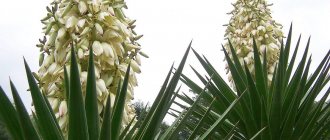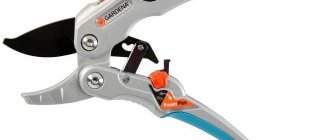What is a garden sprayer
Purpose . A sprayer is an effective garden tool that allows you to apply a thin film of various preventative agents to crop plants to combat insects. You can also fertilize plants and apply various useful additives to the soil.
Construction . Garden sprayers are structurally a portable container with a volume of 2 to 11 liters, with a special element built inside - a pump. A hose and a rod, sliding (telescopic) or non-sliding (standard), are attached to the container. Filters are installed at the outlet of the spray bar, which trap large particles and impurities, thereby protecting the sprayer from damage. Filters come in two types: cylindrical and flat, and a rotating nozzle allows you to select the appropriate type of liquid spray jet.
Models:
- manual lever;
- pump-action;
- knapsack;
- battery and gasoline;
- garden hangings.
Range of sprayers
The modern market offers a wide range of sprayers from leading domestic and foreign manufacturers - Tuman, Kuhn, Lemken, Amazone, Berthoud. Among others, it is worth highlighting equipment for applying fertilizers and protective agents for pest control from the German company Lemken, which supplies the market with highly productive and very efficient models.
Sprayer Lemken Albatros
Lemken trailed field sprayers guarantee professional plant protection and optimal watering. The Primus series with a tank from 2400–4000 l demonstrates excellent performance, maneuverability and economical consumption. The Albatros series includes models for efficient crop production, which are customized to the individual needs of the farm.
Types of garden sprayers. Advantages and disadvantages
Hand lever sprayers
This is the simplest and most cost-effective type of design, working on the principle of manually pumping liquid.
To create the working pressure necessary to spray the liquid, move the handle up and down. The volume of the liquid reservoir is from 0.5 to 2 liters. Used for processing:
- greenhouse vegetables;
- seedlings;
- flowers on the clubs.
Advantages:
- ease of use;
- low cost;
- reliability and versatility.
Flaws:
- small tank volume;
- not suitable for processing large areas.
The cost of a manual sprayer is low, from 250 to 400 rubles.
Pump sprayers
Such models are practically no different from conventional hand sprayers. Volumes of pump designs range from three to twenty liters.
For the convenience of carrying sprayers, the modern market offers the use of mobile models on a belt - knapsacks, designed to be worn on the back. For more reliable fastening and fixation, such models also have a waist belt that prevents the structure from moving to the side. A sprayer of this model has a sliding boom with a rotating nozzle; locking button for long-term spraying; a pump pump built into the lid, which creates a pressure of 3-4 atmospheres. Used for processing:
- large plots;
- fruit trees.
Advantages:
- comfort of wearing;
- ease of control;
- possibility of processing large areas.
Flaws:
- high price;
- danger of working at high atmospheric pressure, which is pumped into the structure’s containers.
The cost of Chinese and domestic models ranges from 700 to 1800 rubles, the price of European manufacturers (German, Italian) with a tank volume of 5-12 liters ranges from 2000 to 7800 rubles.
Battery sprayers
This is one of the popular types of sprayers.
Does not require manual pumping and allows you to spray plants and shrubs for several hours without recharging the battery. The battery sprayer is charged from a regular electrical network. Models differ not only in the volume of the tank, but also in the duration of operation without recharging the battery. The design of the model consists of a liquid tank, a hose, two spray tubes and three nozzles. to monitor battery charging . For convenient operation and transportation, the sprayer has a shoulder strap.
Recent Entries
Chainsaw or electric saw - what to choose for the garden? 4 mistakes when growing tomatoes in pots that almost all housewives make Secrets of growing seedlings from the Japanese, who are very sensitive to the soil
It is applied for:
- processing large areas of the site;
- processing tall trees.
Advantages:
- processing radius 8−12 meters;
- ease of maintenance and operation;
- processing a large area;
- no noise.
Flaws:
- The average operating time of battery sprayers without recharging is no more than three hours .
The cost of battery-powered sprayer models ranges from 18,000 to 22,000 rubles . It is possible to choose budget models. Their cost will range from 3,000 to 7,000 rubles.
Gasoline sprayers
The motorized sprayer is the most efficient model of garden sprayer, thanks to the complete automation of processes.
The model is equipped with a powerful two-stroke engine that runs on a mixture of gasoline and oil. The sprayer has a liquid pump, so you can easily spray tall trees. The average tank capacity is designed for 14-18 liters of liquid. All controls are concentrated on the handle: on-off button and gas lever. The structure is moved using belts, on the back or on wheels, which are included in the kit.
It is applied for:
- processing large areas up to 5 hectares;
- big trees.
Advantages:
- equipped with straps for carrying behind the back or wheels for easy transportation;
- large tank volumes from 12 to 23 liters;
- processing radius 8−18 meters;
- ideal for farmers involved in large-scale crop production.
- The process of spraying fertilizers and pesticides is as automated as possible.
Flaws:
- high price;
- regular refueling;
- noise during operation.
The cost of the sprayer is from 20,000 to 53,000 rubles , the budget option costs from 12,000, but has poor build quality and is unreliable in operation.
Mounted garden sprayers
Such models of sprayers are used only in conjunction with a tractor or any other heavy equipment. The sprayer has a tank for fertilizers or toxic chemicals, with a volume of 200 to 2000 liters. Only used for processing large farmlands. The cost of this model starts from $1,600.
Engine and device
Manufacturers offer electric and gasoline sprayers. In the event that the device will be used to process a small garden plot (about 6 acres), then an electric sprayer will be optimal. You don't have to bother with fuel, refuel the unit, or lubricate the engine. The advantages also include: environmental friendliness, ergonomics, ease of use.
However, if you grow plants professionally and have a large area at your disposal, then it is better to give preference to a mobile motorized sprayer.
As for the type of device, there are the following:
- manual;
- knapsack;
- pump-action
The former are characterized by a small volume, so they are used for treating house plants, flower beds, and small bushes. Can also be used to clean glass.
Backpacks are used for spraying fertilizers or chemicals on personal plots and vegetable gardens. Such sprayers consist of a container equipped with a hose and a spray gun. With the help of belts, the design is put on the shoulders and placed behind the back. The capacity of the container can be from 13 to 25 liters.
Pump-type ones have a smaller capacity (from 3 to 16 liters) and are used mainly in the country for treating potatoes from pests. For portability, the device is equipped with wheels, making it easy to move to any distance.
How to choose a garden sprayer?
The latest models of garden sprayers can work with both liquids and powder mixtures.
An important parameter when choosing a sprayer is the capacity of the device’s reservoir; the duration of continuous operation depends on it. The larger the scope of work, the more voluminous and productive the sprayer should be. For example, when processing trees you will need from two to ten liters of liquid, for berry bushes - up to one liter, and when processing plants and vegetable crops, you need to choose a sprayer based on one to two liters of liquid per ten square meters.
When choosing a garden sprayer, you need to consider the following nuances:
- the quality of the material used to make the body, hose and nozzle. It is better to choose a metal barbell;
- density and quality of connection of structural parts;
- quality and reliability of fasteners;
- brand name of the manufacturer of garden tools;
- availability of replaceable nozzles;
- availability of detailed instructions in Russian;
- the ability to purchase spare parts and consumables for the selected model of garden sprayer;
- warranty period and the availability of service centers in order to quickly fix the problem in the event of a breakdown;
- price.
Before making the final choice, you need to try on the model that best meets the requirements of your choice. Make sure that the model is comfortable and the design is not too heavy. Check that the drain valve is working properly and test the design.
Design of operation and basic adjustments of the sprayer
Design of operation and basic adjustments of the OPSH-15 sprayer
Sprayers are designed to destroy pests, pathogens, and weeds by applying finely sprayed liquid pesticides to the plant. The typical technological process of the sprayer is as follows. The working fluid is continuously mixed in the tank of the machine in order to maintain its homogeneous composition and is released under pressure onto the plant in a finely sprayed form. The main basic assembly units of sprayers are unified. Through their different combinations and the use of additional working bodies, various modifications of sprayers have been created. The main assembly units of the sprayer: pump, mixing device, pressure regulator, spraying device, filling device. The OPSH-15 sprayer is designed to protect field crops and can work with all pesticides used in the form of solutions, suspensions and emulsions. The operating speed of the sprayer during main operations is 610 km/h, working width is 15 m, productivity is 915 ha/h, working fluid consumption is 75,300 l/ha, operating pressure in the boom manifold is no more than 0.8 MPa, tank capacity is 1200 l. To work on a field with tramlines, the distance between the wheels is expanded to 1800 mm and the ground clearance is increased to 500 mm. The sprayer tank is filled with water or a working solution using filling agents through the neck in which the filling filter is located. If refilling supplies are not available, you can use the sprayer’s own pump. The sprayer pump is driven from the tractor PTO. Before work, you need to inspect the machine and make sure that it is assembled and coupled correctly, all rod and bolt connections are tightened. Then 100 liters of water are poured into the tank and the tractor PTO is smoothly turned on at reduced engine speeds, having previously set the clutch valve handle to the closed position. Check the operation of the sprayer without turning on the flow of liquid through the nozzles. After making sure that the pump, cardan drive, pressure regulator, suction and discharge communications are functioning normally (there are no unusual noises or knocks), set the handle of the coupling valve to the open position. Smoothly turn on the tractor PTO and, gradually increasing the speed to nominal, use the regulator handwheel to bring the pressure in the pressure system to 1.2 MPa and carry out the treatment for 5 minutes. The effectiveness of spraying largely depends on the correct adjustment of the sprayers to a given liquid flow rate. Before starting to operate the sprayer, check: the operation of the pressure gauge; cleanliness of the tank, nozzles; pump performance; tightness of the hydraulic system; the serviceability of the mixer and the flow of working fluid back into the tank; horizontal bar. The flow rate of the sprayer's working fluid per unit time (min) depends on the pressure in the discharge communication, the number of spray tips and the size of their outlet openings. Before starting to process the crops, set the sprayer to the specified flow rate of the working fluid. When working with a tractor sprayer, the fluid consumption rate is calculated using the formula
where Q is the liquid consumption rate, l/ha; H—liquid output from one tip, l/min; n is the number of tips; V—unit speed, km/h; B - sprayer working width; 600 is the conversion factor. The liquid output from the tip depends on the diameter of the outlet and the pressure in the sprayer system, which must be adjusted to obtain a given liquid flow rate. The liquid output from one tip is calculated by the formula
The consumption rate of the working fluid is first determined by calculation, then the actual fluid consumption is checked in the field. To do this, the tanks are filled with water and spraying is carried out at a set pressure and tractor speed. For example, when spraying the soil after sowing beets with pyramin at a dose of 4 kg/ha in a continuous manner, it is necessary to consume 400 l/ha of water with a working width of the sprayer of 8 m (16 tips), a control distance of 100 m, and a treated area of 800 m2. During a control check, the flow of liquid from all tips (throughput) will be 30.4 liters. Having the data obtained, you can determine the actual liquid consumption per 1 ha:
Knowing the actual consumption of working fluid per 1 hectare, the amount of the drug to fill the sprayer tank is specified:
Based on the rate of consumption of the working solution and the speed of movement of the unit, determine the liquid consumption of one sprayer according to the table. 1. To achieve a given rate of liquid consumption, along with regulating the pressure, it is necessary to change the number of tips, the distance between them, the working width and the speed of movement of the sprayer. In each specific case, the necessary calculations are carried out and adjustments are made before starting work. Deflector sprayers are installed on the boom for working with herbicides at a working fluid flow rate of 75...150 l/ha, or slot sprayers are installed for working with herbicides at a solution flow rate of 150...300 l/ha. Slot nozzles are adjusted so that the spray patterns are directed back by approximately 5... 10°. The sprayer booms are installed so that they are 50...60 cm higher than the crop being treated.
Table 1 Determination of the flow rate of working fluid by one sprayer
4. Basic adjustments of machines for preparing land for development and cultural and technical work (D-719/D-514A)
The long-base bucket leveler D-719 is designed for easy leveling of irrigated lands and leveling the soil after rough leveling work performed with bulldozers and scrapers. The planner consists of a sectional frame 1 (Fig. 4.1), a bucket 2, running wheels and controls. The welded frame is made in the form of a sliding spatial truss. The front section of the frame is pivotally connected to the front end 4, and the rear section is rigidly fixed to the beam of the rear wheels. The distance (base) between the front and rear wheels is 15 m. For long-distance transport, the longitudinal dimensions of the frame are reduced by sliding the middle section and part of the front into the rear.
Figure 4 — Long-base planner D-719
The front end 4 consists of a drawbar, a jack, a hydraulic cylinder, a trailer, an indicator rail and a clamp. A jack is used to raise or lower the front end of the drawbar when coupling the leveler to the tractor. The working body—bottomless bucket 2 with a volume of 3 m3—is rigidly mounted on the rear frame of the leveler. It is equipped with a back and two side walls. Knives 6 are attached to the bottom of the rear wall. Skis 3 are mounted on the side walls of the bucket, protecting it from damage during transportation. In the working position, the skis are raised and fixed. The bucket is filled with soil, cut with a knife on the hills, drags it to level places, pours the soil into the depressions and levels out the depressions. Due to the long longitudinal base, the bucket does not copy, but plans the surface of the field, cutting off mounds more than 0.2 m high and up to 0.3 m long. The P-4 leveler only smoothes out unevenness of smaller heights and larger longitudinal dimensions. During operation, the position of the bucket is adjusted by the hydraulic cylinder of the trailer, and the height of its location relative to the surface is determined by the indicator rail. When leveling an area with dense soil, the blade of the bucket knife should be installed at the level of the reference plane, which corresponds to the zero reading on the rack. In an area with loose soil, the knife blade is attached above the supporting plane of the wheels to the extent that they are immersed in the soil. seeder combine cultural machine At low humidity, the soil is loosened before leveling, and lumps and blocks are destroyed with heavy rollers. The surface of the site is planned in two mutually perpendicular directions. Depending on the microrelief, to level the surface it is necessary to make from two to four passes along one track. At the same time, it is ensured that the joints between adjacent passages do not have ledges and rollers more than 4 cm high. Brush cutters are of two types: with passive and active cutting devices. Brush cutters of the first type are equipped with horizontal knives, the blade of which is positioned at an angle of 28...32° to the direction of movement. They are good at cutting shrubs with rigid trunks and a diameter at the root collar of at least 2...3 cm, but they shift part of the fertile soil layer. Brush cutters of the second type are equipped with knives that, in addition to linear movement, perform rotational or reciprocating movement. When cutting bushes, such knives do not damage the turf. Brush cutter D-514A (Fig. 4.4) is designed for clearing areas overgrown with bushes and small forests with a trunk diameter of up to 120 mm. The brush cutter is mounted on the T-130BG tractor. The main parts of the brush cutter: push frame 14, body 11, guard 12, grinder and hydraulic system. The horseshoe-shaped pushing frame 14 is made up of two box-section semi-frames. The frame is connected to the body by a spherical hinge. The frame with the body is raised and lowered by hydraulic cylinders 13. Blades 15 with knives 16 are attached to the sides of the body 11, forming a dihedral wedge with an angle of 64°. A flat wedge 10 is welded to the front part of the body. The frame of the body is sheathed on top with sheet steel. A socket is welded to the transverse beam of the body, into which the ball part of the removable head of the pushing frame fits. The cabin is protected from falling trees and branches by fence 12, and the radiator is protected by a shield. The working body slides along the soil surface, using a wedge 10 to split stumps and push apart fallen trees. Knives 16 cut the bushes, and double-sided blades 15 place them in windrows. The quality of the cut depends on the height of the knives above the field surface and the sharpness of their blades. By rearranging the height of the copying skis, the distance between the knives and the soil surface is changed within 0...2 cm. In areas clogged with stones, the knives are raised.
5. How to increase the productivity and quality of operation of a mower or forage harvester DON-680
When preparing many types of forage, plants are mowed with mowers. They are classified according to the following criteria: purpose - ordinary and mower-conditioners, which, in addition to mowing, also flatten stems; number of cutting devices - single-, double- and triple-bar; type of cutting apparatus - segmented-finger, fingerless and rotary; method of aggregation - mounted, semi-mounted, trailed and self-propelled. The cutting speeds of the blades of harvesting machines are of great importance both for the quality of the cut and for the cutting force. When cutting at insufficient speed, the stem is first flattened by the segment blade pressing into it, then some of the fibers are torn, some are chipped off, and the rest is cut off or torn off. The force required for such a ragged cut is relatively high. As the speed increases, the cutting surface improves, there are fewer torn fibers, and at the same time the cutting force decreases. Average cutting speeds in the cutting devices of harvesting machines should be no lower: when mowing grass 2.1-2.4 m/sec, when harvesting grain crops - 1.4-1.6 m/sec. However, with increasing cutting speed in harvesting machines, the inertial forces of the oscillating masses increase (proportional to the square of the angular velocity of the crank). As the speed increases, the consumption of traction force for idle movements of the knife also increases very strongly. Therefore, you should not increase the knife speed more than necessary to obtain a clean cut. The self-propelled forage harvester "Don-680" is 50% unified with the grain harvesters SK-5 "Niva", "Don-1200", "Don-1500" due to the use of individual units: chassis, hydraulic, brake, electronic and electric systems, cabins, control systems, etc. The combine is equipped with a 205 kW engine, which allows it to perform energy-intensive work (for example, harvesting corn for silage, including in the waxy ripeness phase of the grain) with high productivity and degree of grinding. Comfortable working conditions are created in the cabin. The quality of feed chopping is ensured by the presence of three cutting modes (length 3, 5.8 and 20 mm), the installation of an additional chopper and the use of a rotary header for harvesting corn. To reduce losses of chopped green mass and improve the filling of vehicles, including heavy vehicles with a volume of up to 60 m3, a flow accelerator and an extended silo pipeline are used in the design of the grinding unit. To ensure high-quality and productive work, forage harvesters must be promptly and carefully prepared and configured depending on the type of feed being harvested. Before starting work, check the cutting apparatus. To ensure a high-quality cut of the stems and prevent the knife from clogging with plant matter in the extreme positions of the knife, the center lines of the segments must coincide with the center lines of the fingers. Depending on the type of feed being harvested, the combine is adjusted to the required cutting length by changing the number of knives on the drum or the feed speed of the feed device (switching gearbox gears). It must be remembered that the shorter the cutting length, the higher the energy intensity of the grinding process and, consequently, the lower the productivity of the combine. The quality of grinding depends on the sharpness of the drum knives. The thickness of the cutting edge of the knives of all forage harvesters should be 0.3 mm. To achieve this thickness, you need to sharpen the knives at least once every 5 days using the device equipped with the combine. When cleaning over-moistened or dry mass, you should use a chopping apparatus with a squirter. It improves the quality of grinding and transportation of mass through the silo pipeline, but due to its high energy consumption it reduces the productivity of the combine. During harvesting, the speed of movement of the combine must be selected so as to ensure maximum productivity with minimal losses. When harvesting lodged plants and working along a slope, reduce the speed.
Hydraulic
OG-301
The device is manual and works similar to a syringe. To assemble such a sprayer, you need a plastic bottle, because... He doesn't have his own tank. The device is connected to the bottle by screwing it onto the thread of its neck. Usually used to care for indoor flowers.

OG-301
OG-301 sprays from a short distance - up to 40 cm. It does not have the ability to lock the button.
OG-112
The device is a backpack , designed for 12 liters of liquid. It has a filler neck and a telescopic fire nozzle. The sprayer is convenient for both right-handers and left-handers: the pump lever can be installed under any hand. The key is fixed if necessary.

OG-112
Spray radius – up to 1680 millimeters. It is used for feeding plants, for treating large areas of forest, plantations, and gardens against pests.
Also, for processing and caring for a large area of land, you will need a Patriot walk-behind tractor, a Foreman, a Viking cultivator, a Swift, a lawn seeder and a cart for the walk-behind tractor.
Using a sprayer, you can water and irrigate plants, disinfect surfaces, clean, and extinguish forest fires spreading through the lower tier of the forest.
OG-115
Backpack sprayer, tank volume – 15 liters. It differs from the previous model only in the capacity of the tank.











